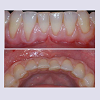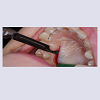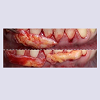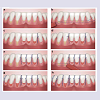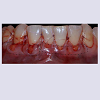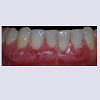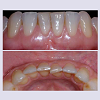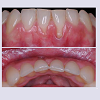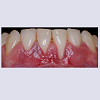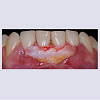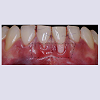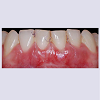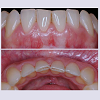Journal of Clinical & Medical Case Reports
Download PDF
Case Report
*Address for Correspondence: Vincent Ronco, Periodontology & Implantology, 11 rue Michel Chasles, 75012 Paris, France, Tel: +33 (0)143071010; E-mail: dr.vincentronco@yahoo.fr
Citation: Ronco V, Dard M. Esthetic and Functional Treatment of Gingival Recessions in the Mandible: A Micro-Surgical and Mini-Invasive Concept Based on Tunneling Procedure and Controlled Connective Tissue Graft Exposure: Case Reports. J Clin Med Case Reports. 2017;4(1): 7.
Copyright © 2017 Ronco V, et al. This is an open access article distributed under the Creative Commons Attribution License, which permits unrestricted use,distribution, and reproduction in any medium, provided the original work is properly cited.
Journal of Clinical & Medical Case Reports | ISSN: 2332-4120 | Volume: 4, Issue: 1
Submission: 30 January, 2017 | Accepted: 08 March, 2017 | Published: 14 March, 2017
Connective tissue grafting with a tunnel approach is a surgical option that has been used and amended continually over the last 20 years [4-7]. The tunneling procedure aims to detach the vestibular soft tissues with only an intra-sulcular incision. The procedure generates a gap inside which the connective tissue graft can be inserted. Basically, there are two surgical options for positioning the connective tissue graft within its recipient bed: the graft can be either completely submerged or partially exposed. Both options lead to gingival biotype thickening, but there are differences in terms of keratinized tissue creation, muco-gingival line displacement, buccal vestibular depth modifications and esthetics [8-13].
Preparation of the graft recipient site
Placement of the grafts
Protection of the surgical site and post-operative recommendations
This case was treated with the same philosophy as the previous case: a muco-periosteal envelope was performed from tooth 32 to 42 and a connective tissue graft was exposed from the tip of the recessions to the cemento-enamel junctions of the affected teeth (Figures 9-11). The intention was to trigger reconstitution of the initial amount of keratinized tissue for esthetic and functional purposes.
As in the previous case, the graft did not exhibit any necrosis even at its exposed area. The healing process was well advanced after 1 week (Figures 12). From 1 week and up to 4 years, complete root coverage was observed (Figure 13a). Location of the muco-gingival line and buccal vestibular depth remained unchanged. New soft tissue, induced by secondary healing at the surface of the exposed graft, presented the clinical characteristics of keratinized tissue. Keratinized tissue height increased from 0 to 4 mm at tooth 31. No discontinuity in color or texture between the native and the newly created soft tissue could be clinically discerned. Occlusal view examination did not reveal excessive thickening (Figure 13b). After 1 month and for up to 4 years, periodontal probing exhibited a physiological sulcus.
Esthetic and Functional Treatment of Gingival Recessions in the Mandible: A Micro-Surgical and Mini-Invasive Concept Based on Tunneling Procedure and Controlled Connective Tissue Graft Exposure: Case Reports
Vincent Ronco1* and Michel Dard2
- 1Private practice, Periodontology & Implantology, France
- 2College of Dentistry, New York University, USA
*Address for Correspondence: Vincent Ronco, Periodontology & Implantology, 11 rue Michel Chasles, 75012 Paris, France, Tel: +33 (0)143071010; E-mail: dr.vincentronco@yahoo.fr
Citation: Ronco V, Dard M. Esthetic and Functional Treatment of Gingival Recessions in the Mandible: A Micro-Surgical and Mini-Invasive Concept Based on Tunneling Procedure and Controlled Connective Tissue Graft Exposure: Case Reports. J Clin Med Case Reports. 2017;4(1): 7.
Copyright © 2017 Ronco V, et al. This is an open access article distributed under the Creative Commons Attribution License, which permits unrestricted use,distribution, and reproduction in any medium, provided the original work is properly cited.
Journal of Clinical & Medical Case Reports | ISSN: 2332-4120 | Volume: 4, Issue: 1
Submission: 30 January, 2017 | Accepted: 08 March, 2017 | Published: 14 March, 2017
Abstract
This article, via two clinical cases, describes a micro-surgical treatment protocol that combines a connective tissue graft with a supra-periosteal tunnel technique for correction of recession defects in the mandible. We propose a treatment rationale where the connective tissue graft is voluntarily exposed on the root surface using controlled exposure, resulting in predictable keratinized tissue creation. The graft is left uncovered on the whole recession height, which triggers the biomimetic target of recreating the initial muco-gingival situation. After healing, this treatment rationale can achieve both functional and esthetic outcomes: increased gingival height and thickness, stable location of the muco-gingival line, preservation of buccal vestibule depth, root coverage, and color and texture matching between the native and the newly created soft tissue. The technique may be a suitable alternative for the treatment of single and multiple Miller class I, II and III recession defects in the mandible, especially in challenging situations when the initial amount of keratinized tissue is low and/or gingival biotype is thin.Introduction
Plastic periodontal surgery can be indicated for both functional and/or esthetic reasons in the upper as well as in the lower jaw [1]. Particular treatment requirements are necessary in the mandibular arch as it presents several anatomic specifications. Gingiva is often thin in the mandible, particularly in the anterior region, not only for constitutive reasons, but also because of the type of teeth and/or protrusion [2]. Besides, keratinized tissue height is often limited and buccal vestibular depth is shorter than in the maxilla [3]. Therefore muco-gingival surgery in the mandible would ideally achieve the following effects:- Cover dental roots and harmonize gingival collars
- Thicken gingival biotype
- Increase keratinized tissue height
- Generate new soft tissue harmonious in texture, color, and thickness with the pre-existing muco-gingival environment
- Keep the muco-gingival line at its native position, not only to preserve buccal vestibular depth, but also to maintain the reddish appearance of the alveolar mucosa at an esthetic distance from the dental collars
If the graft is totally submerged, the exposed root is covered by the traction of the pre-existing soft tissues, resulting in a significant shift in the muco-gingival line location and subsequently a reduction in vestibular depth. This option also leads to a limited and unpredictable creation of keratinized tissue [14-16].
If the graft is partially exposed, traction on the pre-existing tissues to cover the root is limited, which implies a minimal shift in the location of the muco-gingival line, and a minor modification of the vestibule depth. In addition, if the graft undergoes complete revascularization, new keratinized tissue is created by secondary healing, leading to a predictable gingival height augmentation that is equal to the height of the exposed graft [9].
In this paper, although literature usually recommends complete coverage of the connective tissue graft, we propose a treatment rationale where the graft is voluntarily exposed on the root surface using controlled exposure [10-13]. The graft is left uncovered over the whole recession height, which triggers the biomimetic target of recreating the initial muco-gingival situation. Via a micro-surgical approach, complete revascularization of the graft including its exposed portions could be obtained, leading to esthetic and functional results. The procedure is described using two patients as representative examples of the intended proof of concept.
Case Report 1
This 34-year-old female showed adequate plaque control but multiple Miller class I and II recessions at tooth positions 31, 32, 41, 42 and 43 (Figures 1a and 1b) [17]. The patient complained about the unsightly appearance of these recessions and dental sensitivity. The recessions ranged from 0.5 mm at tooth 41 to 4 mm at tooth 42, and remaining keratinized tissue ranged from 0.5 mm at tooth 42 to 3.5 mm at tooth 41. We decided to cover the roots, harmonize gingival collars and recreate the original amount of keratinized tissue via connective tissue grafting. As an occasional smoker, the patient was instructed to cease tobacco consumption 1 week prior to the intervention and not to resume until at least 2 weeks post-operatively.Preparation of the graft recipient site
Pre-operatively, interdental contact points were splinted with flow resin to enable suspended suturing. Etching and bonding were not necessary due to the existing undercuts in these areas. Following anesthesia, the roots were lightly planed by ultrasonics for decontamination. Root convexities were not reduced.
Surgery began with intra-sulcular incisions around the neck of the affected teeth with a single-edge micro-blade (MIM 64; Hu-Friedy Mfg. Co. Ltd., Chicago IL, USA), allowing access for a supraperiosteal tunnel preparation, using tunneling instruments (Hu-Friedy TKN 1, TKN 2; Hu-Friedy Mfg. Co. Ltd., Chicago IL, USA). Tunneling consisted of a partial thickness preparation initiated at the sulcular area and then extended to the mucosa. At the mucosa level, attached muscles were released using a tunneling knife (Hu-Friedy K012KP03A6, Hu-Friedy Mfg. Co. Ltd., Chicago IL, USA) to release the buccal gingiva-papillary complex without visible incision. Papillae were then detached up to their tips with their periosteum using a specially designed instrument (Hu-Friedy PH26M, Hu-Friedy Mfg. Co. Ltd., Chicago IL, USA).
Retrieval of the connective tissue graft
Connective tissue graft was harvested from the palate using a minimally invasive single incision technique, between the canine and the first molar with a conventional 15c blade (Figure 2) [18]. The graft was gently retrieved using micro-tweezers and placed in a sterile container with physiological saline. The resulting envelope at the donor site was closed using two absorbable 5.0 sutures. The graft was longitudinally divided into two pieces with a new conventional 15c blade, and trimmed with micro-scissors (Hu-Friedy curved microcastro scissors, Hu-Friedy Mfg. Co. Ltd., Chicago IL, USA) to reach a height of 4 mm and thickness of 1 to 1.5 mm. The graft covering tooth 31 to 33 was 10 mm long and the graft covering tooth 42 to 44 was 11 mm long (Figure 3).
Placement of the grafts
A lateral traction suture, modified from a vertical mattress, is used as a positioning suture (6.0 polypropylene). The needle was inserted in the upper part of the papilla between 32 and 33 and passed through the tunnel to the recession on 42. The needle engaged the graft at one end before being passed back through the tunnel by the same route and finally passed through the papilla between 32 and 33. The graft could then be easily pulled along the surgical site within the tunnel in the distal direction. Once the graft was positioned, the lateral traction suture was converted to a vertical traction suture by wrapping around the splinted contact point before tightening the knot. The same procedure was performed at the other end of the graft to complete mesio-distal positioning without excessive tension. The same procedure was performed once again to place the second graft (Figures 4a-4g).
Setting of the graft exposure by help of proper suturing
Once the grafts were secured laterally, the graft/flap positioning and the setting of the exposure began with vertical mattress sutures located on each papilla. The needle was inserted buccally through the flap and the graft next to the muco-gingival junction. The needle pierced the graft in the expected position and reappeared approximately 1 mm apical to the tip of the papillae. The needle was then recaptured, slid underneath the contact point to reappear at the lingual side and passed over the splinted contact point. The knot was tightened on the buccal aspect and gentle pressure was applied. The procedure was repeated for each interdental area to set the graft exposure and stabilize the buccal tissues (Figures 4g-4h and Figure 5). Due to the position of the contact point (coronal and lingual to the suture sites), such suturing provides adequate vertical traction and compression of the wound. By passing through the graft at a particular location, the suture also determines the level of graft exposure. The objective was to expose the graft over the whole recession height withminimal displacement of the muco-gingival line.
Figure 4: Schematic representation that shows the procedure of insertionand display of the connective tissue grafts. a) Surgical site after tunneling procedure.b) Suture used to tract the first graft into its bed.c) Lateral traction suture converted into to vertical suspended suture after graft insertion (dotted line materializes the graft in its covered portions).d) Immobilization of the other end of the graft.e) Vertical suspended suture at each papilla to set the graft exposure and generate gentle compression of the graft-flap complex on the deep planes (root and periosteum).f) Insertion of the second graft by the same procedure.g) Immobilization of the other end of the second graft.h) Second graft inserted and secured with vertical suspended sutures.
No periodontal dressing was used to protect the operating site. The patient was instructed to consume soft food and avoid brushing the operated area during the first postoperative week. Cleaning is ensured by mouthwash with 0.12% chlorhexidine bigluconate (Eludril, Pierre Fabre SA, Castres, France) and local antiseptic gel with 0.2% chlorhexidine bigluconate (Elugel, Pierre Fabre SA, Castres, France). Sutures were removed after 7 days, after which brushing was allowed using apost-operative tooth brush (Inava 7/100, Pierre Fabre SA, Castres, France) before resuming normal hygiene after 2 weeks.
Medications
An antibiotic (amoxicillin) is administered for 7 days. For patient comfort, an anti-inflammatory (corticosteroid) and an analgesic (paracetamol) are included in the prescription for 4 days. 0.12% chlorhexidine bigluconate mouthrinse and 0.2% chlorhexidine bigluconate gel are prescribed for plaque control for 1 week.
Follow-up
At the palate, the selected harvesting technique resulted in uneventful healing and limited post-operative pain (cessation of paracetamol consumption reported by the patient after 2 days).
At the recipient site, 1 week after surgery, the grafts did not exhibit any necrosis even at their exposed portions (Figure 6). Reepithelization of the exposed portions of the connective tissue was complete at 1 month. From 1 week and up to 4 years complete root coverage (gingiva at the cemento-enamel junction) was observed (Figure 7a). Muco-gingival line location and buccal vestibular depth remained unchanged. New soft tissues, induced by secondary healing at the surface of the exposed graft portions, presented the clinical characteristics of keratinized tissue (aspect and immobility). Keratinized tissue height increased in every tooth involved in the procedure proportionally to the height of graft exposed. A higher increase was noted at tooth 32 and reached 3 mm, in accordance with the 3 mm of graft left uncovered. No discontinuity in color or texture between the native and the newly created soft tissues could be clinically discerned. Occlusal view examination did not reveal any excessive thickening (Figure 7b). After 1 month and up to 4 years, periodontal probing exhibited a physiological sulcus. Tooth sensitivity immediately disappeared after surgery.
Figure 7: Clinical situation 4 years after surgery. a) Frontal view, b) Occlusal view.Note the amount of keratinized tissue created, especially at tooth 42 (0.5 mm before to 3.5 mm after surgery). Visual blending between initial and reconstructed tissues as well as marginal gingiva harmonization can also benoted.
Case Report 2
This additional case is provided to strengthen the validity of the chosen approach. This 45-year-old female non-smoker presented with recessions in the mandibular anterior region (Miller class I at tooth 41 and class II at tooth 31). Recessions ranged from 2 mm at tooth 41 and 4 mm at tooth 31. Remaining keratinized tissue ranged from 2 mm at tooth 42 to 0 mm at tooth 31 (Figures 8a and 8b). She complained about the unsightly appearance of these recessions and dental sensitivity.Figure 11: Immediate post-operative view. The dotted black line stands for the contour of the graft. According to the treatment rationale, the graft was left uncovered over the whole recession height and muco-gingival line location remained unchanged. Graft exposure was 2 mm at tooth 41 and 4 mm at tooth 31. Note the particularly unfavorable ratio of covered-uncovered graft area at tooth 31.
Discussion
Connective tissue graft associated with a tunnel flap preparation has been documented and has shown excellent results in the maxilla, however data on this technique are scarce in the mandible [19-23]. Furthermore, literature generally recommends complete coverage of the grafts [10-13]. In this paper we suggest a treatment rationale for the mandible where the connective tissue graft is intentionally left uncovered on the root surface with controlled exposure. Provided that the graft achieves total revascularization, the potential benefits of the approach are both esthetic and functional, including covering dental roots and harmonizing gingival collars, thickening gingival biotype, creating keratinized tissue, stability of the muco-gingival line and buccal vestibular depth, and generate new soft tissue harmonious with the pre-existing muco-gingival environment. In addition, this approach may be suitable for a wide range of clinical situations, especially when initial amount of keratinized tissue is low and/or gingival biotype is thin.Vascular aspects
Exposing a portion of the connective tissue graft on a vascular bed such as the dental root surface implies a risk of necrosis in its area of emergence. In our clinical cases, all exposed portions were successfully revascularized (despite a particularly unfavorable ratio covered/uncovered at tooth 42 in case 1 and 31 in case 2). Multiple elements influence complete revascularization of grafts among which flap design and suturing are tremendously important.
As the root surface is non-vascularized, the interface between the graft and the vascularized regions of the recipient site is critical. The exposed portion of the graft is initially nourished by diffusion and then vascularized by the graft regions underlying the flap [24,25]. The mini-invasive partial-thickness tunnel preparation described here enhances maximum blood supply for the graft, a sit requires neither vertical nor horizontal incision. It might be speculated that vascularization sources are threefold, coming from the apical and lateral surrounding regions [26-28], as well as from the deep (periosteum) and the superficial (gingiva and alveolar mucosa) plane [7,27].
Sutures in periodontal plastic surgery have tremendous importance as they allow intimate contact between the affected tissues and wound stabilization during the healing process [29]. Advanced tissue maturation at 1 week suggests that thin (6.0) anchored vertical mattress sutures allow stabilization of the graft/flap, together with minimal vascular collapse. These observations are in accordance with Burkhardt and Lang (2005), who demonstrated improved graft vascularization with a micro-surgical suturing approach compared to a traditional macro-surgical approach [30].
Functional aspects
Although periodontium can be kept healthy with minimal keratinized tissue height [31], daily periodontal observation indicates that an esthetic result, and therefore patient satisfaction, seems to be improved by the presence of a significant gingiva height above the muco-gingival line [32-35]. Literature also indicates that thick gingiva seems to be more stable over the time [36-38]. Therefore we consider that regaining a significant band of keratinized tissue and thickening the gingival biotype without reducing the buccal vestibule should betriggered in mandibular periodontal plastic surgery.
We know from Langer & Langer (1985) that keratinized tissue creation is possible from connective tissue graft exposure [39]. If the graft achieves complete revascularization, secondary healing can occurs at its surface, inducing an immediate gain in keratinized tissue. Our approach is in accordance with these early findings, butis based on less invasive surgery that favors vascular potential and complete graft revascularization. By promoting graft exposure over the whole recession height, the biomimetic goal of recreating the native muco-gingival situation can be initiated. If the graft achieves complete revascularization, keratinized tissue creation is immediate, predictable and substantial.
Gingival biotype thickness augmentation may have a favorable influence on long-term tissue stability and could even induce creeping attachment [40-43]. Furthermore, connective tissue grafting allows homogenous gingival thickening. Covered connective tissue grafts have shown excellent capability to thicken gingival biotype [44,45]. Although it would be logical to think that connective tissue may be more prone to skrinkage if exposed, our clinical cases indicate from before-after occlusal views that reconstructed areas are in continuity with the pre-existing soft tissues up to 1 and 4 years after surgery.
Since buccal vestibule is usually short in the mandible [3,46], muco-gingival surgery should avoid reducing its depth, not only to facilitate patient hygiene but also to avoid coronal displacement of muscular tensile forces that could favor recurrence of recessions [47]. Our approach protects root coverage by graft exposure and avoids coronal tissue displacement. It might be speculated that respecting the vestibular depth may play a role in the long-term persistence of root coverage.
Esthetic aspects
Scientific literature indicates that esthetic evaluation of soft tissues is multi-parametric [13,48]. Root coverage in periodontal plastic surgery is essential to achieve esthetic results but several other aspects should be considered, such as absence of scar line, harmony of soft tissue color, uniformity of surface aspect, homogeneity of thickness, presence of sufficient keratinized tissue height and regularity of collar lines. The outcomes provided by the suggested technique fulfill all these approach expectations.
The design of the tunnel technique eliminates all incisions except intra-sulcular; consequently scar formation from incisions cannot occur. Scar formation may also be related to iatrogenic suturing. The use of both refined suture material and suspended suturing technique should therefore be stressed [32,49].
It is usually recommended that the connective tissue graft be submerged because visible discontinuity or boundary area may occur between native and newly formed gingival [10-13]. However, we noticed no significant demarcation neither in our cases nor in similar mandibular cases treated in our daily practice. One reason could be that these esthetic complications occur mostly with thick biotypes, resulting in a potentially higher frequency in the maxilla than the mandible.
Periodontal esthetics seem to be improved by the presence of significant gingival height above the muco-gingival line [41-44]. With our treatment philosophy, recessions are covered via the creation of new keratinized tissue, not by traction of the pre-existing tissues. As a result, a band of keratinized tissue is recreated with minimal shift of the muco-gingival line, which keeps the unsightly reddish appearance of the alveolar mucosa at an esthetic distance from the dental crowns [13,50]. Root coverage with a totally submerged graft would involve undesired coronal displacement of the alveolar mucosa, resulting in impaired esthetics [16].
Conclusion
The described procedure may be a suitable alternative for the treatment of any single or multiple Miller class I, II and III recession defects in the mandible. This approach may be particularly appropriate for the correction of sites with minimal keratinized tissue height and thin gingival biotypes, unlike laterally displaced flap, double lateral bridging flap, or coronally advanced flap, which would not be applicable in such situations [51-54].As a minimal shift of the muco-gingival line is induced, our approach may also be beneficial for sites with shallow buccal vestibule, compared to coronally advanced flap or coronally advanced flap with fully covered connective tissue graft. Moreover, the limited pain that appears to be associated with the single incision harvesting techniquefor connective tissue graft 18 compared to a free gingival graft makes the procedure more acceptable for patients [18,55].
The procedure detailed in this publication allows achievement of esthetic and functional outcomes. The technique may be relevant for the treatment of any single or multiple Miller class I, II and III recession defects in the mandible, especially in challenging situations when initial amount of keratinized tissue is low and/or biotype is thin and/or buccal vestibule is short. Future multi centric studies with a suitable number of patients and calibrated measurements are necessary to accurately assess the reproducibility of the procedure.
References
- (1996) Consensus report. Mucogingival therapy. Ann Periodontol 1: 702-706.
- Eger T, Müller HP, Heinecke A (1996) Ultrasonic determination of gingival thickness. Subject variation and influence of tooth type and clinical features. J Clin Periodontol 23: 839-845.
- Tibbetts LS Jr, Ochsenbein C, Loughlin DM (1976) Rationale for the lingual approach to mandibular osseous surgery. Dent Clin North Am 20: 61-78.
- Allen AL (1994) Use of the supraperiosteal envelope in soft tissue grafting for root coverage. I. Rationale and technique. Int J Periodontics Restorative Dent 14: 216-227.
- Allen AL (1994) Use of the supraperiosteal envelope in soft tissue grafting for root coverage. II. Clinical results. Int J Periodontics Restorative Dent 14: 302-315.
- Azzi R, Etienne D, Takei H, Carranza F (2009) Bone regeneration using the punch-and-tunnel technique. Int J Periodontics Restorative Dent 29: 515-521.
- Zuhr O, Fickl S, Wachtel H, Bolz W, Hürzeler MB (2007) Covering of gingival recessions with a microsurgical tunnel technique: case report. Int J Periodontics Restorative Dent 27: 457-463.
- Fu JH, Su CY, Wang HL (2012) Esthetic soft tissue management for teeth and implants. J Evid Based Dent Pract 12 Suppl 3: 129-142.
- Han JS, John V, Blanchard SB, Kowolik MJ, Eckert GJ (2008) Changes in gingival dimensions following connective tissue grafts for root coverage: comparison of two procedures. J Periodontol 79: 1346-1354.
- Rosetti EP, Marcantonio RA, Rossa C Jr, Chaves ES, Goissis G, et al. (2000) Treatment of gingival recession: comparative study between subepithelial connective tissue graft and guided tissue regeneration. J Periodontol 71: 1441-1447.
- da Silva RC, Joly JC, de Lima AF, Tatakis DN (2004) Root coverage using the coronally positioned flap with or without a subepithelial connective tissue graft. J Periodontol 75: 413-419.
- Sedon CL, Breault LG, Covington LL, Bishop BG (2005) The subepithelial connective tissue graft: part I. Patient selection and surgical techniques. J Contemp Dent Pract 6: 146-162.
- Kerner S, Sarfati A, Katsahian S, Jaumet V, Micheau C, et al. (2009) Qualitative cosmetic evaluation after root-coverage procedures. J Periodontol 80: 41-47.
- Thoma DS, Benić GI, Zwahlen M, Hämmerle CH, Jung RE (2009) A systematic review assessing soft tissue augmentation techniques. Clin Oral Implants Res 20 Suppl 4: 146-165.
- Thoma DS, Buranawat B, Hämmerle CH, Held U, Jung RE (2014) Efficacy of soft tissue augmentation around dental implants and in partially edentulous areas: a systematic review. J Clin Periodontol 41 Suppl 15: S77-S91.
- Cordioli G, Mortarino C, Chierico A, Grusovin MG, Majzoub Z (2001) Comparison of 2 techniques of subepithelial connective tissue graft in the treatment of gingival recessions. J Periodontol 72: 1470-1476.
- Miller PD Jr (1985) A classification of marginal tissue reaction. Int J Periodontics Restorative Dent 5: 8-13.
- Hürzeler MB, Weng D (1999) A single-incision technique to harvest subepithelial connective tissue grafts from the palate. Int J Periodontics Restorative Dent 19: 279-287.
- Zabalegui I, Sicilia A, Cambra J, Gil J, Sanz M (1999) Treatment of multiple adjacent gingival recessions with the tunnel subepithelial connective tissue graft: a clinical report. Int J Periodontics Restorative Dent 19: 199-206.
- Tözüm TF, Keçeli HG, Güncü GN, Hatipoğlu H, Sengün D (2005) Treatment of gingival recession: comparison of two techniques of subepithelial connective tissue graft. J Periodontol 76: 1842-1848.
- Khuller N (2009) Coverage of gingival recession using tunnel connective tissue graft technique. J Indian Soc Periodontol 13: 101-105.
- Lee CT, Hamalian T, Schulze-Späte U (2015) Minimally invasive treatment of soft tissue deficiency around an implant-supported restoration in the esthetic zone: Modified VISTA technique: Case report. J Oral Implantol 41: 71-76.
- Harris RJ, Miller R, Miller LH, Harris C (2005) Complications with surgical procedures utilizing connective tissue grafts: a follow-up of 500 consecutively treated cases. Int J Periodontics Restorative Dent 25: 449-459.
- Kon S, Caffesse RG, Castelli WA, Nasjleti CE (1984) Revascularization following a combined gingival flap-split thickness flap procedure in monkeys. J Periodontol 55: 345-351.
- Langer L, Langer B (1993) The subepithelial connective tissue graft for treatment of gingival recession. Dent Clin North Am 37: 243-264.
- Blanes RJ, Allen EP (1999) The bilateral pedicle flap-tunnel technique: a new approach to cover connective tissue grafts. Int J Periodontics Restorative Dent 19: 417-419.
- Guiha R, el Khodeiry S, Mota L, Caffesse R (2001) Histological evaluation of healing and revascularization of the subepithelial connective tissue graft. J Periodontol 72: 470-478.
- Tözüm TF, Dini FM (2003) Treatment of adjacent gingival recessions with subepithelial connective tissue grafts and the modified tunnel technique. Quintessence Int 34: 7-13.
- Wong ME, Hollinger JO, Pinero GJ (1996) Integrated processes responsible for soft tissue healing. Oral Surg Oral Med Oral Pathol Oral Radiol Endod 82: 475-492.
- Burkhardt R, Lang NP (2005) Coverage of localized gingival recessions: comparison of micro- and macrosurgical techniques. J Clin Periodontol 32: 287-293.
- Miyasato M, Crigger M, Egelberg J (1977) Gingival condition in areas of minimal and appreciable width of keratinized gingiva. J Clin Periodontol 4: 200-209.
- Abolfalzi N, Saber FS, Latzi A, eskandari A (2010) Evaluation of alteration in mucogingival line following use of subepithelial connective tissue graft. Indian J Dent Res 21: 174-178.
- Zucchelli G, De Sanctis M (2000) Treatment of multiple recession-type defects in patients with esthetic demands. J Periodontol 71: 1506-1514.
- Zucchelli G, De Sanctis M (2005) Long-term outcome following treatment of multiple Miller class I and II recession defects in esthetic areas of the mouth. J Periodontol 76: 2286-2292.
- Zucchelli G, De Sanctis M (2013) Modified two-stage procedures for the treatment of gingival recession. Eur J Esthetic Dent 8: 24-42.
- Ericsson I, Lindhe J (1984) Recession in sites with inadequate width of the keratinized gingiva: An experimental study in the dog. J Clin Periodontol 11: 95-103.
- Steiner GG, Pearson JK, Ainamo J (1981) Changes of the marginal periodontium as a result of labial tooth movement in monkeys. J Periodontol 52: 314-320.
- Wennström JL, Lindhe J, Sinclair F, Thilander B (1987) Some periodontal tissue reactions to orthodontic tooth movement in monkeys. J Clin Periodontol 14: 121-129.
- Langer B, Langer L (1985) Subepithelial connective tissue graft technique for root coverage. J Periodontol 56: 715-720.
- Oh SL (2009) Attached gingiva: histology and surgical augmentation. Gen Dent 57: 381-385.
- Bonacci FJ (2011) Hard and soft tissue augmentation in a postorthodontic patient: a case report. Int J Periodontics Restorative Dent 31: 19-27.
- Grover HS, Yadav A, Yadav P, Nanda P (2011) Optimizing gingival biotype using subepithelial connective tissue graft: a case report and one-year follow-up. Case Rep Dent 2011: 263813.
- Puisys A, Linkevisius T (2015) The influence of mucosal tissue thickening on crestal bone stability around bone-level implants. A prospective controlled clinical trial. Clin Oral Implants Res 26: 123-129.
- Kan JY, Rungcharassaeng K, Lozada JL (2005) Bilaminar subepithelial connective tissue grafts for immediate implant placement and provisionalization in the esthetic zone. J Calif Dent Assoc 33: 865-871.
- Anderson LE, Inglehart MR, El-Kholy K, Eber R, Wang HL (2014) Implant associated soft tissue defects in the anterior maxilla: a randomized controlled trial comparing subepithelial connective tissue graft and acellular dermal matrix allograft. Implant Dent 23: 416-425.
- Ward VJ (1976) The depth of the vestibular fornix in the mandibular region in health. J Periodontol 47: 651-655.
- Greenwell H, Vance G, Munninger B, Johnston H (2004) Superficial-layer split-thickness flap for maximal flap release and coronal positioning: a surgical technique. Int J Periodontics Restorative Dent 24: 521-527.
- Fürhauser R, Florescu D, Benesch T, Haas R, Mailath G, et al. (2005) Evaluation of soft tissue around single-tooth implant crowns: the pink esthetic score. Clin Oral Implants Res 16: 639-644.
- Zuhr O, Rebele SF, Thalmair T, Fickl S, Hürzeler MB (2009) A modified suture technique for plastic periodontal and implant surgery--the double-crossed suture. Eur J Esthet Dent 4: 338-347.
- Cairo F, Nieri M, Cattabriga M, Cortellini P, De Paoli S, et al. (2010) Root coverage esthetic score after treatment of gingival recession: an interrater agreement multicenter study. J Periodontol 81: 1752-1758.
- Grupe HE (1966) Modified technique for the sliding flap operation. J Periodontol 37: 491-495.
- Harris RJ (1992) The connective tissue and partial thickness double pedicle graft: a predictable method of obtaining root coverage. J Periodontol 63: 477-486.
- Harris RJ, Harris AW (1994) The coronally positioned pedicle graft with inlaid margins: a predictable method of obtaining root coverage of shallow defects. Int J Periodontics Restorative Dent 14: 228-241.
- Tarnow DP (1986) Semilunar coronally repositioned flap. J Clin Periodontol 13: 182-185.
- Miller PD Jr (1982) Root coverage using a free soft tissue autograft following citric acid application. Part 1: Technique. Int J Periodontics Restorative Dent 2: 65-70.


